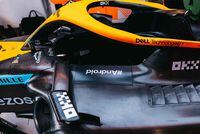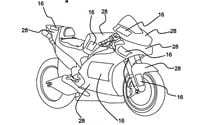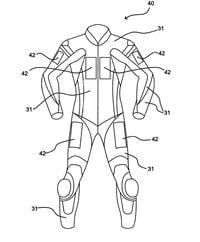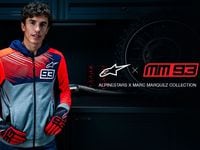At the US Formula 1 Grand Prix in October, the McLaren team demonstrated a new advertising technology with display screens instead of decals in key locations on the car to allow graphics that change in real time. The people behind the idea have already got their sights set on bringing it to motorcycle racing where the relative lack of advertising real estate could make it even more valuable—and they’re even looking to incorporate the flexible screens into riders’ leathers.
Seamless Digital, part of Silverstone Paint Technology, is the firm behind the two screens used on either side of the McLaren cockpit. First appearing at the Friday free practice in Austin, Texas, during the Grand Prix in October, the screens were relatively small but blended neatly into the bodywork and were positioned to be in good view of onboard cameras, cycling between different adverts as the cars lapped Circuit of The Americas. The entire setup, including both screens, control circuits, and a battery (separate from the vehicle’s main electrical system), weighed only 6.7 ounces. The idea is described in detail in a patent registered to Silverstone Design Limited, a related company based at the same location at the Silverstone circuit in the UK, which also expands on the possibilities of the technology in motorcycle racing.
While cars have large expanses of bodywork to be filled with sponsorship, MotoGP bikes have substantially less, and the rider’s own leathers make up a large proportion of the surface area on view. Since sponsors are the main way of funding racing, and key locations for logos can be enormously valuable, the ability to change the advert displayed on those locations on-the-fly could unlock additional funding for teams using the technology, essentially allowing the same ad space to be sold multiple times. The idea is already commonplace in the form of digital billboards, so translating it to race cars or racebikes—essentially mobile billboards themselves—makes a huge amount of sense. The challenge is to make the technology light and unobtrusive enough to avoid any competitive disadvantage.
Seamless Digital’s tech is essentially similar to the e-paper used in e-readers like Kindles, but fitted on a thin, flexible screen. It’s not at the stage where flashy, color movies could be shown, but it’s more than up to the job of cycling through monochrome company logos, as demonstrated in the McLaren application. For bikes, the real challenge, and one that’s explained in some depth in the Silverstone Design Limited patent, is to integrate the screens into a rider’s leathers. The company suggests the e-paper itself can be made flexible enough to cope with the movement of a rider, and by inserting it into transparent plastic pockets sewn over the leather it can be added without impairing the integrity of the suit. A more rigid screen could be used in areas like the aero hump behind the rider’s head where there’s already limited flexibility in the leathers.
Given the amount of TV time that’s spent looking at riders’ rears during on-board footage from tail-mounted cameras, it’s not hard to imagine that e-paper screens on their backs could be a popular place to position ads. Not only would it allow multiple companies to essentially buy a timeshare slot of prime-ad positioning, but it would make it much easier to change the graphics—perhaps for limited promotions or simply to swap between a brand’s logo and its ad message. Although we’ve yet to hear of any motorcycle race teams adopting the idea, the system’s exposure on the McLaren F1 cars is sure to raise its profile enough to pique their interest.



/cloudfront-us-east-1.images.arcpublishing.com/octane/MPHXIIV54NAU5L6E4SYZHCXVRM.jpg)



/cloudfront-us-east-1.images.arcpublishing.com/octane/WYXFHF4ZOBBTXELIZDB2FJXU64.jpg)
/cloudfront-us-east-1.images.arcpublishing.com/octane/K5FNV7ONUVDXJJ2H5BIWUGBGTI.jpg)
/cloudfront-us-east-1.images.arcpublishing.com/octane/MGVKP5VTNJHQ7FWNAHIWX4OHO4.jpg)
/cloudfront-us-east-1.images.arcpublishing.com/octane/6JEYTSIZQRHPJAVVPRLWZU63UM.jpg)
/cloudfront-us-east-1.images.arcpublishing.com/octane/XJU3VJZSDFEOVDBJTRXTTLTN5U.jpg)

/cloudfront-us-east-1.images.arcpublishing.com/octane/A6O3TEZF45BVFG2KKOUMPWEYM4.jpg)
/cloudfront-us-east-1.images.arcpublishing.com/octane/MHVFMH2YN5DT3EOZPLXKNFP3VM.jpg)
/cloudfront-us-east-1.images.arcpublishing.com/octane/VILA5L7CTBGOJGDKM2YAOCR6VU.jpg)
/cloudfront-us-east-1.images.arcpublishing.com/octane/GZMZRTYRS5A75G2EJDDGXLJEEE.jpg)
/cloudfront-us-east-1.images.arcpublishing.com/octane/6KWAL3TFNJBGTJMJSKQ2C6I3IY.jpg)
/cloudfront-us-east-1.images.arcpublishing.com/octane/GK5I5R3X7JCABGCKAKT4XY2K7U.jpg)


/cloudfront-us-east-1.images.arcpublishing.com/octane/RGUT3Y65IFGDFMLHQ3U7G5UUQE.jpg)

/cloudfront-us-east-1.images.arcpublishing.com/octane/37CSHD6CKRHYXHRB67EOLDS6XM.jpg)
/cloudfront-us-east-1.images.arcpublishing.com/octane/FYB7GKDGLVE3JKXMM75JTG2RYA.jpg)
/cloudfront-us-east-1.images.arcpublishing.com/octane/3ECVMM622VAZHIOLI6Q6ILWULU.jpg)
